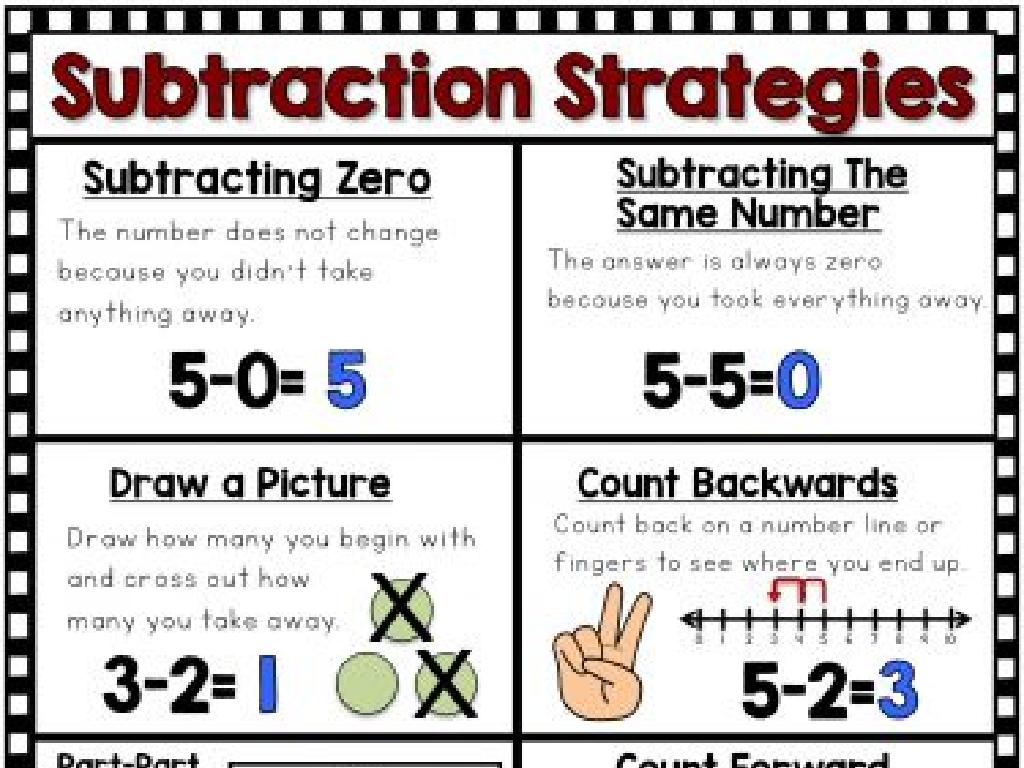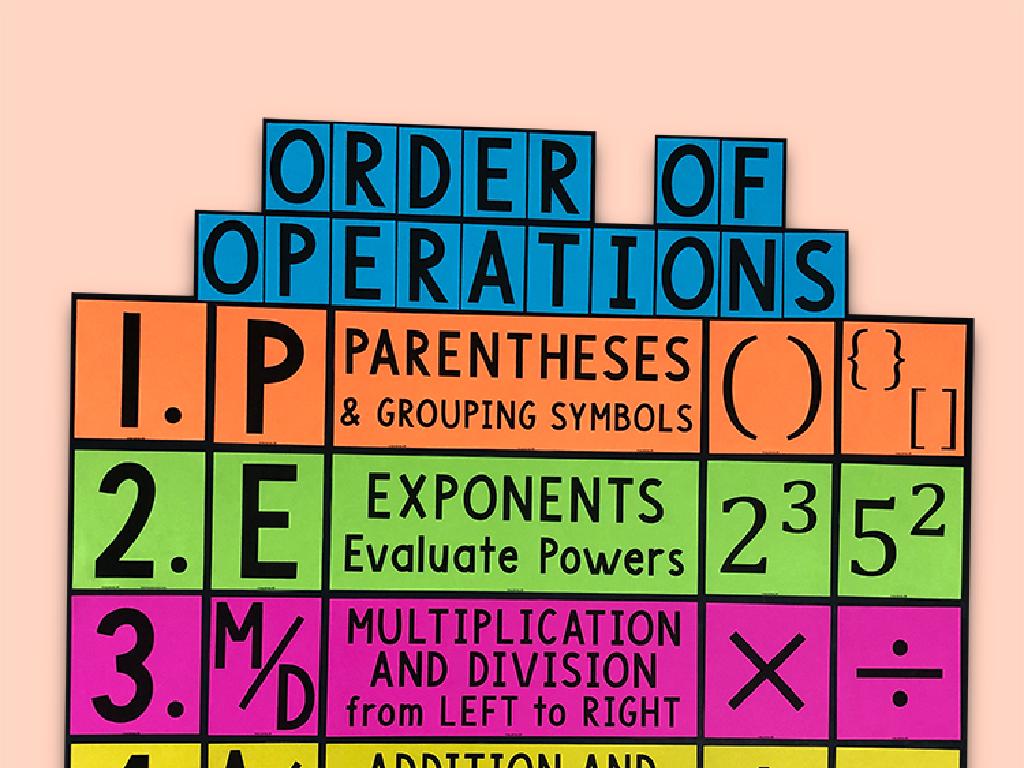Are The Modifiers Used Correctly?
Subject: Language arts
Grade: Seventh grade
Topic: Conjunctions
Please LOG IN to download the presentation. Access is available to registered users only.
View More Content
Introduction to Modifiers
– Understanding sentence modifiers
– Modifiers describe or provide more detail about other words.
– Defining what modifiers are
– Words, phrases, or clauses that add detail to sentences.
– The role of modifiers for clarity
– They prevent confusion, making writing clear and specific.
– Examples of correct usage
– ‘The quickly running dog’ vs ‘The dog running quickly’.
|
This slide introduces the concept of modifiers in the context of conjunctions for a seventh-grade language arts class. Begin by explaining how modifiers function to add description and specificity to sentences, enhancing the reader’s understanding. Clarify that modifiers can be adjectives, adverbs, phrases, or clauses. Emphasize the importance of placing modifiers correctly to maintain clarity and avoid confusion in writing. Provide examples to illustrate correct modifier usage and how misplaced or dangling modifiers can lead to ambiguous or humorous interpretations. Encourage students to think of their own examples and to be mindful of modifier placement in their writing.
Exploring Modifiers in Sentences
– Adjectives modify nouns
– Describe or quantify things, e.g., ‘seven’ apples, ‘blue’ sky
– Adverbs modify verbs, adjectives, or other adverbs
– Often end in ‘-ly’, e.g., ‘quickly’ ran, ‘extremely’ happy
– Modifiers enhance sentence detail
– They provide more information, making sentences vivid
– Correct usage of modifiers
– Ensure modifiers are placed next to the word they describe
|
This slide introduces students to the concept of modifiers, specifically adjectives and adverbs, and their role in adding detail to sentences. Adjectives are used to describe nouns, giving more information about things like quantity, color, size, etc. Adverbs typically modify verbs and can also modify adjectives or other adverbs, often expressing manner, degree, frequency, or time and usually ending in ‘-ly’. It’s crucial for students to learn how to use modifiers correctly to avoid confusion in their writing. For example, misplaced modifiers can change the meaning of a sentence. Encourage students to practice by identifying modifiers in sentences and creating their own detailed sentences using adjectives and adverbs correctly.
Correct Use of Modifiers
– Proper modifier placement
– Modifiers should be placed close to the word they describe to avoid confusion.
– Avoiding misplaced modifiers
– Misplaced modifiers can change the meaning of a sentence, often humorously.
– Examples of correct usage
– ‘The dog happily wagged his tail’ shows ‘happily’ modifies ‘wagged’.
– Practice identifying modifiers
|
This slide aims to teach students the importance of correctly using modifiers within sentences. Emphasize that modifiers are words, phrases, or clauses that provide description in sentences. When placed improperly, modifiers can lead to unclear or incorrect meanings. Provide clear examples to show how the placement of modifiers can alter the meaning of a sentence. Encourage students to practice by identifying modifiers in sentences and determining if they are used correctly. Use exercises where students correct sentences with misplaced modifiers to reinforce the lesson.
Conjunctions and Modifiers
– Conjunctions connect with modifiers
– Conjunctions join words, phrases, or clauses and can work with modifiers to add detail.
– Coordinating conjunctions’ role
– Coordinating conjunctions (FANBOYS) link equal parts of a sentence, often used with modifiers to add clarity.
– Subordinating conjunctions’ usage
– Subordinating conjunctions introduce dependent clauses and can affect the placement of modifiers for clear meaning.
– Ensuring modifier accuracy
– Check that modifiers are placed next to the word they describe to avoid confusion.
|
This slide aims to explain how conjunctions interact with modifiers in sentences. Emphasize that conjunctions serve as connectors in the language and can significantly impact the clarity of a sentence when used with modifiers. Coordinating conjunctions (for, and, nor, but, or, yet, so – FANBOYS) often work in tandem with modifiers to join independent clauses or words of equal grammatical rank. Subordinating conjunctions introduce dependent clauses and can influence where modifiers are placed, which is crucial for maintaining the intended meaning of a sentence. Highlight the importance of correct modifier placement to avoid ambiguity. Provide examples to illustrate correct and incorrect usage, and encourage students to practice identifying and correcting misplaced modifiers in conjunction with conjunctions.
Correcting Misplaced Modifiers
– Understanding modifier errors
– Modifiers must be close to the word they describe to avoid confusion.
– How to find misplaced modifiers
– Look for words/phrases that seem out of place or make the sentence awkward.
– Fixing modifier placement
– Reposition modifiers to clarify which word they’re modifying.
– Class activity: Spot the errors
|
This slide aims to teach students how to identify and correct misplaced modifiers, which are words or phrases that are separated from the words they modify, leading to potential confusion or a change in meaning. Start by explaining common errors and show examples where modifiers are not placed next to the word they are supposed to modify. Teach students to look for clues in the sentence structure that indicate awkwardness or ambiguity. Provide strategies for fixing these errors by moving the modifiers closer to their intended targets. The class activity will involve students working on example sentences to identify and correct misplaced modifiers, fostering a practical understanding of the concept.
Class Activity: Correct the Modifiers
– Work in pairs on sentences
– Identify incorrect modifiers
– Look for modifiers that don’t clearly match the words they’re describing
– Correct the modifiers together
– Discuss and decide how to best correct these modifiers
– Share corrections with the class
|
This activity is designed to help students understand the correct use of modifiers in sentences. Students will pair up and receive a worksheet with sentences containing incorrectly used modifiers. They will work together to identify the errors and make the necessary corrections. Afterward, each pair will have the opportunity to share their corrected sentences with the class, fostering a collaborative learning environment. As a teacher, circulate the room to assist pairs as needed. Possible activities for different pairs could include correcting sentences with misplaced modifiers, dangling modifiers, or squinting modifiers. This will help students recognize common modifier errors and learn how to fix them.
Conclusion: Mastering Modifiers and Conjunctions
– Recap: Modifiers and Conjunctions
– Review how modifiers/conjunctions work together
– Importance of correct modifiers
– Correct modifiers clarify meaning without confusion
– Homework: Craft 5 sentences
– Use modifiers to add detail and interest to your sentences
– Share your sentences next class
– Be prepared to discuss how you used modifiers
|
This slide wraps up our lesson on modifiers and conjunctions. Begin with a brief review of what modifiers are (words that describe or change other words) and how conjunctions (words that connect clauses) work in a sentence. Emphasize the importance of placing modifiers correctly to avoid ambiguity and confusion. For homework, students will write five original sentences, each demonstrating the use of modifiers effectively. Encourage creativity and the use of a variety of modifiers. In the next class, students will share their sentences and discuss the impact of the modifiers on the clarity of their sentences. This exercise will reinforce their understanding and application of the concepts learned.





